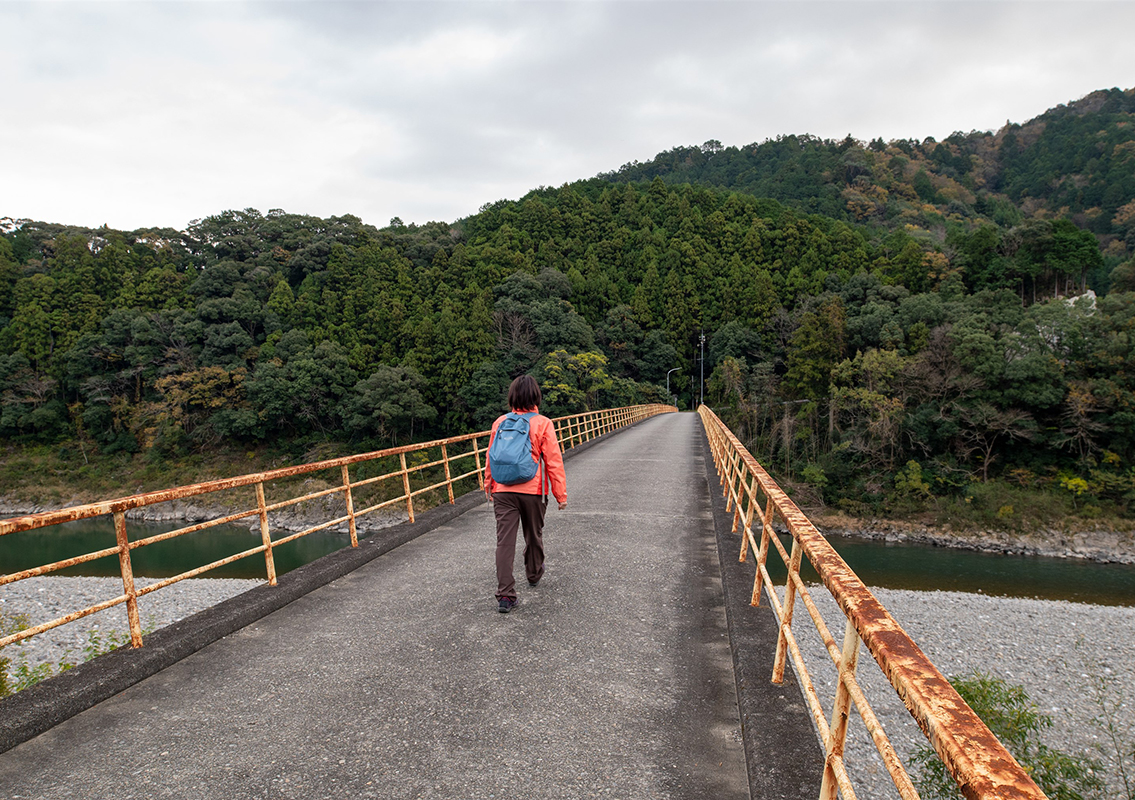Shinzan Yukoku (Deep Mountain Valley) Pilgrimage Route

Shinzan Yukoku (Deep Mountain Valley) Pilgrimage Route
You will see a tranquil path continuing into the mountains after crossing the Suii Bridge over the Nakagawa River from Oi village in Anan City. The river flows along the mountain trail, and you will see the plunge pool under the waterfall peeking through the trees. After some time, you will see the "Wakasugiyama Cinnabar Mine Site," where cinnabar was mined to make vermilion pigment. You will reach the Tairyuji Temple (temple No. 21) if you go through the difficult sections of the trail called "Henro Korogashi." You will see rows of cedar trees over hundreds of years old soar into the sky, creating a majestic atmosphere. The large site is lined with various shrines and halls that were rebuilt in the Edo period, such as the Niomon Gate, the Rokkaku Kyozo (Hexagon-shaped Sutra Repository), and the Daishi Hall. After leaving the temple, the road continues for a while before reaching the town of Asebi, situated deep in the mountains. Be careful as some areas have heavy traffic.
Shinzan Yukoku (Deep Mountain Valley) Pilgrimage Route(10.5Km)

 Spots to photograph
Spots to photograph
If you wish to receive a certificate, please take a photo that includes yourself at the designated photo point for each course.
Nearby sightseeing spots

-
1
 Suii Bridge
Suii BridgeRead as "Suiibashi," the bridge is located in the middle of the pilgrimage route that pilgrims take from Kakurinji Temple (temple No. 20) to Tairyuji Temple (temple No. 21). At 3 m wide, this simple bridge is narrow and can only be used by mini trucks and people. On a fine day, the beauty of the Nakagawa River colored in vivid green, reflecting the green mountains, will make you stop in your tracks.
-
2
 Wakasugiyama Cinnabar Mine Site (Ancient Mercury Mine)
Wakasugiyama Cinnabar Mine Site (Ancient Mercury Mine)After the war, many stone mortars, stone pestles, and earthenware were excavated during the process to cultivate the land into tangerine fields, and the area became known as the Mercury Vermilion (Cinnabar) Mine Ruins. The ruins include a mining site where cinnabar was mined by breaking the bedrock and a landfill site abandoned because of mining. It is believed that vermilion production peaked from the end of the Yayoi period to the beginning of the Kofun period. Vermilion mercury was used in large quantities for burials in burial mounds in the early Kofun period. It is assumed that the mercury vermilion produced at the Wakasugiyama Site was brought in for the construction of ancient burial mounds in various places, making it an extremely important site for understanding the wide distribution network during the Kofun period.
-
3
 Tairyuji Temple
Tairyuji TempleThis is temple no. 21 out of the 88 temples in the Shikoku Pilgrimage. The temple is said to have been founded by Kobo Daishi in Enryaku 11 (792). Since ancient times, pilgrims have bemoaned the difficult pilgrimages to 1. Shosan-ji Temple, 2. Kakurinji Temple, and 3. Tairyuji Temple. The area is surrounded by old cedar trees that are said to be several hundred years old, and the site is lined with various halls that were rebuilt in the Edo period, including the Niomon Gate, the Rokkaku Kyozo (Hexagon-shaped Sutra Repository), the Main Temple, the Daishi Hall, and the Taho Hall. The Tairyu-ji Temple is also mentioned in Daishi's "Sango Shiiki" as the place where he performed the Kokuzo Gumonji Ho ritual. The "Awa Pilgrimage Road Kamo-Michi," once used by many pilgrims doing the pilgrimage on foot, still has the Choishi (marker stones) from the Muromachi period and has been designated a prefectural historical site.
-
4
 Omatsu Daigongen (Omatsu Gongen)
Omatsu Daigongen (Omatsu Gongen)"Omatsu Daigongen," affectionately known as "Omatsu-san," is considered to be one of Japan's three greatest monster cat legends, along with the cat chaos of Arima and Nabeshima. During the Edo period, a woman named Omatsu, who lived nearby, was executed after directly appealing a magistrate's unjust death sentence over a matter of debt. However, there is a legend that her beloved cat turned into a monster and continued to terrorize the magistrate's house and take revenge on them from generation to generation. The temple was later built by villagers out of compassion for Omatsu, and she became known as the God of competition and wishes. The temple is especially crowded with visitors during the exam season to pray for passing the exams.



